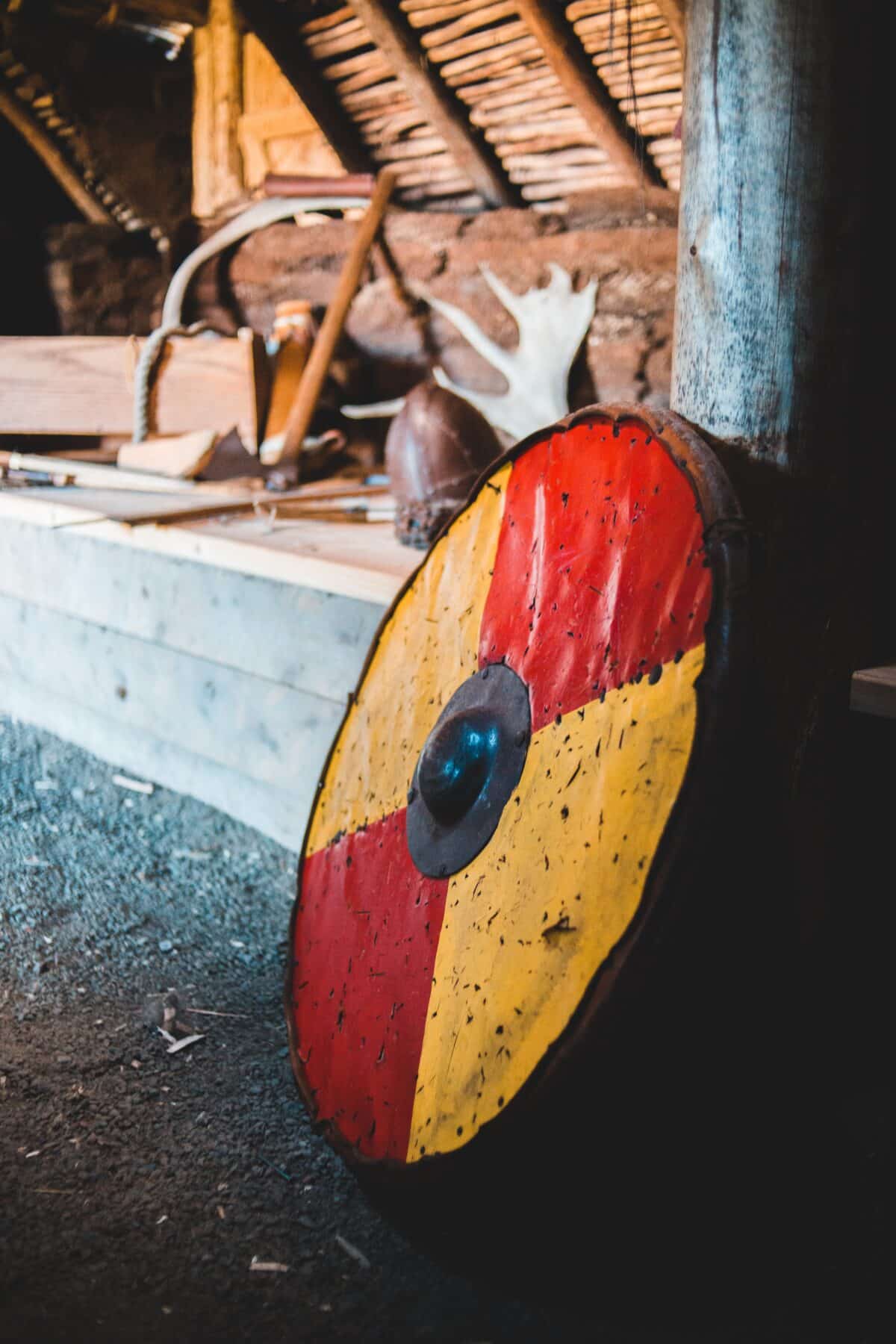In a previous article, I listed some of the most dangerous swords that can be found in the default rules for Dungeons & Dragons, the reason being that the sword is perhaps the most iconic type of weapon in a general D&D setting and one that’s closely associated with fantasy in general. This time, I’ll continue in the same vein, and take a look at that vital piece of equipment that goes into a paladin’s other hand: the shield.
Traditionally, shields haven’t received much love in D&D. The number of different shields available and the level of complexity when it comes to using them have varied from edition to edition of the game. Given that there’s a strong focus on simplicity in the present (fifth) edition, at least as far as combat and skills are concerned, it’s no surprise that there are only a handful (no pun intended) of kinds listed in the books, and the ways they can be used are quite limited. A look in the Player’s Handbook tells us that shields are crafted from either wood or metal, they’re carried in one hand, and they increase your armour class by 2. Meanwhile, there’s a wide range of suits of armour available, each with its own advantages and disadvantages.
While a boost to your armour class isn’t anything to sneeze at, the rules make no distinction between a cracked tea tray strapped to your arm and an inch-thick tower shield forged from iron. All right, that’s stretching it a bit, but you see my point – clearly, ease of use won the day when this snippet of the D&D rules was written. Interestingly, the rules also state that you can’t use more than one shield at a time, which suggests to me that the authors have experience with players who may have walked around like mobile forts hiding behind two shields.
Likewise, the basic rules are rather short on additional ways to use a shield. There’s the Shield Master feat, which lets you use your shield to shove enemies and improve your Dexterity saving throws – useful but hardly spectacular, and given how important feats are, most will choose different ones.
Consequently, a player who wants to make a character that excels to stride into combat proudly wielding a sharp sword and a polished shield doesn’t have much in the way of customisation options. If we’re sticking to the core rules, the only thing that’ll let such heroes shine are magic items.

Fortunately, the chapter in the Dungeon Master’s Guide contains some magically enhanced shields that proper knights and defence-oriented warriors in general can use to boost their protective means. That said, there’s only a handful of them, so it’s assumable that they’re rather rare – which means that they’re a perfect area for homebrewing, but that’s a different topic.
So which shields will this article cover? All of them! Well, at least most of them. I’m not including the Shield of Missile Attraction for obvious reasons (it’s cursed), although I will say that it’s a pretty humorous way to instil a look of panic on a player’s face. And there may be other shields in the core rulebooks that I have missed.
You may wonder why bother to write about shields at all given that there are so few of them, which is a valid question as it takes only a few minutes to find and digest all there is to learn about magic shields in the basic rules. However, as with all these articles, my recommendations are based much more on flair and imagination rather than tactical advantages and power playing. Are you ready? On to the items!
Shield +1, +2 etc
I’ll mention these only for the purpose to offer a few suggestions. Primarily, I’d like to draw attention to the fact that these exist in the first place! I’ve played D&D for nearly 40 years, and I still haven’t come across a regular AC-enhancing shield in any adventure that I’ve taken part in. This strikes me as weird, given how prevalent shields are in fantasy settings such as Dungeons & Dragons. So if you’re a DM, don’t hesitate to sprinkle in one of these if there’s a shield-using character in the adventuring party – the player with thank you!
What’s more, there’s no reason why a shield that “only” provides its user with a bonus to their armour class should look like a nondescript sheet of dull metal. A shield is traditionally decorated with a motif such as an insignia, emblem, coat of arms, or holy symbols. This presents an opportunity for DMs and players to unleash their creative side and come up with imaginary descriptions or even drawings.
And the style of the shield doesn’t have to end with its paintwork. Do a quick search online for medieval shields and you’ll discover a whole range of interesting shapes and forms that can be used as inspiration for personalising the particular shield for a character, villain, or treasure.
Moreover, D&D is a fantasy game, brimming with extraordinary NPCs, creatures, and sights. This opens the door to endless options for customisation of all items. A classic Shield +1 can be studded with spikes or made of incredibly strong glass, it might glow in the dark or have been crafted from a dragon’s scale, it may resemble a giant wooden leaf and have belonged to an elven hero, or perhaps it is painted with cryptic glyphs which, when decoded, lead the adventurers to a long-lost dungeon. In D&D, anything is possible.
With that out of the way, let’s take a closer look at the four magic shields that can be found in the Dungeon Master’s Guide and examine what makes them good – or just interesting!
Arrow-Catching Shield
Remember that fantasy-themed film that you saw in which the hero was targeted by one or more archers and survived only because of their shield, which ended up so riddled with arrows it looked like a flat pincushion? Or the viciously tense scene at the very end of the Battle of the Bastards in Game of Thrones when the master bowman Ramsay Bolton is doing his best to end Jon Snow, who is armed with only a shield? This (or an equivalent) is the shield that they were using!
An Arrow-Catching Shield provides a +2 bonus to your armour class against all attacks that are ranged. In addition, it also enables you to leap in and protect creatures that are within 5 feet of you and targeted by a ranged attack. A good way to become a popular member of the adventuring party! In many ways, this item is a variation on the cursed Shield of Missile Attraction, but with the critical difference that the shield improves your chance to avoid being hit, and it doesn’t automatically make you the target.
In my opinion, this is a great shield in terms of pure flavour. It’s not powerful compared to most other magic weapons or suits of armour, but when a DM makes an effort to narrate how the wielder whips up the shield to catch a hail of crossbow bolts or raises it to slam a thrown spear aside, you really get the feeling that you’re part of an epic fight.
Sentinel Shield
If there’s a member of your group who plays, for example, a vigilant paladin ever on the lookout for the safety of their friends, or a veteran warrior with lightning reflexes who can spot dangers from a mile away, this shield will suit them perfectly. A Sentinel Shield provides you with advantage on all (Wisdom) Perception checks, and also on initiative rolls. At a glance, that might not sound like lots of benefits – until one considers how critical initiatives are to winning combat in D&D, or that Perception checks can mean the difference between being ambushed or stepping right into a deadly trap. I would argue that this is one of the best shields in the game, and it’s excellent for flavour too. Who wouldn’t want to be the one who never misses a threat or always gets to act early in a fight?
Regarding the visual decoration, I suggest that DMs ignore this bit and design it as they see fit. Alternatively, you can be quite playful with it – for example, is it a fish’s, troll’s or dragon’s eye? Is it tiny or almost as big as the shield? Is the eye engraved in a noble silver shield, or is it a fleshy “real” eye that’s been bolted onto the lid of a barrel? Perhaps it’s a fiery extra-dimensional eye inside a two-dimensional sheet of smoky steel?
Animated Shield
This shield is solidly in the realm of the whimsical, and it’s easy to see how it can have been inspired by an animated movie or a fairy tale. As such, it’s also perfectly fitting for the generally super-quirky world of Dungeons & Dragons.
When given a verbal command, the Animated Shield takes on a life of its own, leaves your hand, and zips around in the air to defend you from attacks. The main advantage of this is that you now have both hands free, meaning you can swing a massive two-handed weapon, cast spells, hide behind a rock, or use your action to scramble up a cliff while fleeing a demon that’s breathing down your neck – all while your shield is working to keep you from harm. In other words, it’s silly, comical, and extremely useful. Probably one for campaigns with plenty of magic items and fantastical elements rather than those with a low-fantasy theme.
Spellguard Shield
Last but far from least, this is the pinnacle of magic shields in the core rules. That heavy metal album with a knight whose shield parts the flames of a dragon? Or the paladin who confidently strides into a corrupted tower to face a menacing necromancer? They’re using this shield (or they wish that they were!).
The power of a Spellguard Shield is straightforward but immensely effective: while you hold it in your hands, it provides you with advantage on saving throws against spells and all kinds of magical effects – and spell attacks have disadvantage against you. That’s a serious boost to a character’s defences when going up against a hostile spellcaster. You suddenly have a much better chance to take only half damage from a fireball cast by the enemy army’s sorcerer, and you’re more likely to dodge a firebolt hurled by an unfriendly wizard in a tavern brawl.
If I were a DM who included this shield in my campaign, I would go wild with its appearance. After all, no self-respecting mage would place a phenomenal enchantment like this one on a battered, mundane-looking everyday footsoldier’s shield. They would commission a striking masterwork from the best armourer in the land, and ensure that it was designed in such a fashion that everyone within a mile’s radius knows that this shield is special, and probably means bad news for villains who rely on spells.
That sums up the magic shields that are featured in the rules of D&D! As always, there are also thousands of homebrewed shields hiding online that are waiting to be discovered, and as suggested above, you can have lots of fun tweaking and elaborating on the basic ones. So get your notepads out, switch on your creative brain (and possibly your coffee machine), and get to work on your next magic item for your campaign. Shields up!







